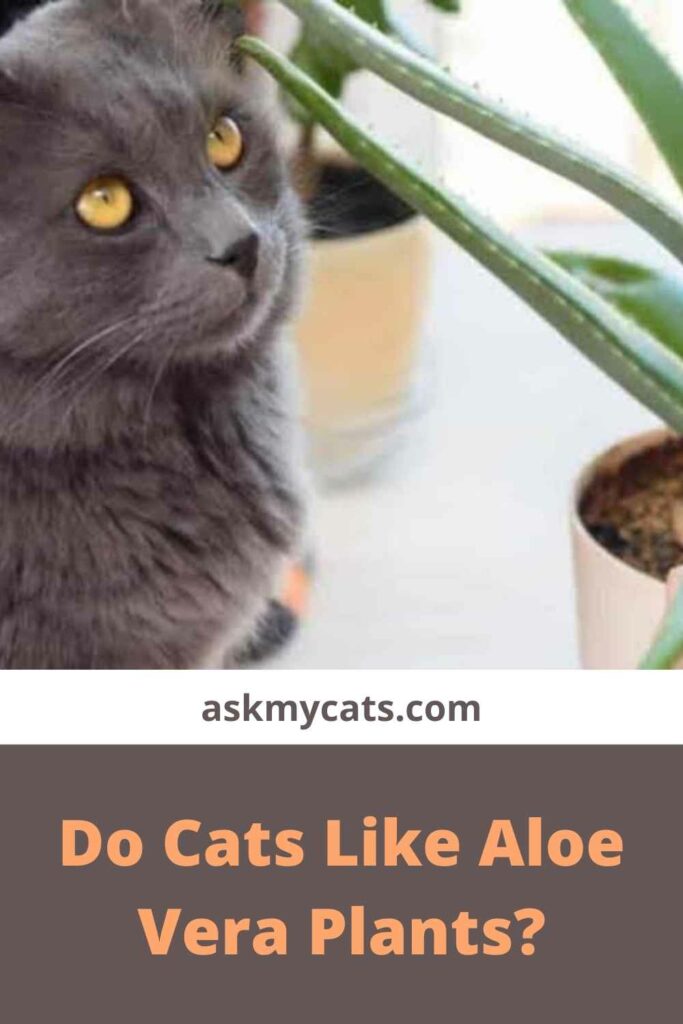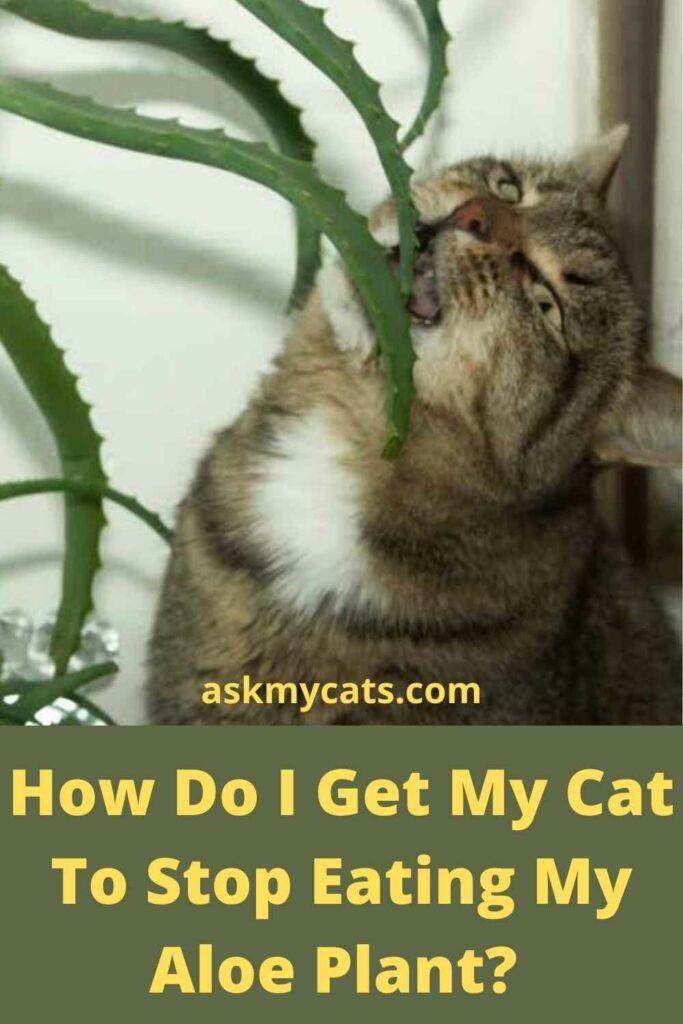Aloe Vera is a typical household plant, not for its beauty but for its medicinal properties. Although aloe juice and pulp may be used to treat a number of human ailments, it is extremely poisonous to cats.
No, cats cannot eat aloe plants. Aloe-eating cats may vomit, get drowsy, or have diarrhea. If you suspect your cat has eaten any part of an aloe plant, contact your veterinarian immediately once.
Keep aloe plants out of the reach of cats and spritz them with vinegar to make them less appealing to curious felines.
If you want to know more about your feline cats and their relationship with aloe plants, keep reading!


Give Your Cat the Perfect Day
Get the Free Ebook!
Do Cats Like Aloe Vera Plants?

Some plants may be devoured by cats, while others are just ignored due to flavor. Cats, while being carnivores, may have become used to consuming plant material discovered in the intestines of their victim.
The latex inside the leaves of the aloe vera plant is the portion of the plant that is poisonous. If you take one of your aloe vera plant’s leaves and break it open you will notice the white sap at the very edge of the leaf and the aloe vera gel as green gooey stuff in the center.
The latex is the white sap surrounding the border of the plant, and it is this portion of the plant that is poisonous to cats. Saponins include glycosides, anthracene, and anthraquinones, which are all found in this compound.
Saponins are purgative chemicals, which means they increase the amount of water and mucus in the colon, which can cause diarrhea and stomach cramps if consumed.
The gel inside aloe vera leaves, on the other hand, is non-toxic. This is the portion of the plant that goes into the aloe vera beverages and skin treatments we use, and it explains why we think the plant is good for us. The aloe vera gel is beneficial when separated, but the plant as a whole has certain negative side effects.
Can Cats Eat Aloe Vera Gel?
Aloe vera gel has been used by humans for years for its wide variety of advantages, and it is a widely used medicinal plant. Vitamins, minerals, amino acids, and anti-oxidants are all included in the gel.
Aloe vera gel, on the other hand, is safe for cats and has several advantages. It’s high in vitamins, minerals, and antioxidants, which assist to moisturize their skin and fur as well as speed up the healing of any open wounds.
There are no side effects from swallowing aloe vera gel, so your cat will be fine licking their hair after you’ve administered the therapy. If your cat ingests a little bit of aloe vera gel, she will be fine.
Can Cats Die From Eating Aloe Vera?
Aloe vera is mild to moderately poisonous herb for cats, despite its reputation as a therapeutic plant for humans. Though your cat may not die, eating aloe vera is extremely detrimental to your cat’s health.
Aloe latex is thought to be a purgative for cats. If an animal consumes a large amount of the plant which is extremely unpleasant to eat, minor gastrointestinal discomfort may occur. Because severe diarrhea can lead to dehydration, it can be life-threatening.
Vomiting, diarrhea, tiredness, sadness, anorexia, tremors, and a change in urine color are all symptoms of eating too much aloe vera. Contact your veterinarian if you notice these in your cat.
What Will Happen If Cat Eats Aloe Plant?
Because aloe vera poisoning in cats may be rather dangerous, it’s important to be aware of the warning signs and symptoms. This way, you can get your cat the care they need as soon as possible, lowering the chances of it becoming a life-threatening condition.
Aloe vera may cause the following symptoms in your cat:
- Urine color changes (urine becomes red)
- Cramps in the abdomen
- Vomiting
- Diarrhea
- Appetite loss
- Depression
- Lethargy
- Tremors
How Much Aloe Is Toxic To Cats?

Fortunately, even though the aloe vera plant is poisonous to cats, it usually only has minor side effects. For one thing, your cat will not be irritated or uncomfortable if it brushes against the plant. Only when they eat the latex within the leaves do they have issues.
Aloe vera is, therefore, less hazardous than some other houseplants, which might create problems if your cat brushes through the leaves.
When the plant is consumed, however, it becomes more lethal. As previously stated, eating the latex inside the plant has purgative properties and can induce diarrhea and stomach pains in your cat.
The degree of diarrhea is determined by the amount of plant consumed. Small amounts of latex will be metabolized by the body in a short time and will cause little more than nausea and discomfort.
When significant amounts of aloe vera are consumed, however, it can be life-threatening. Your cat may experience severe diarrhea, which can result in dehydration. They may require intravenous fluids to help them reestablish electrolyte and fluid balance in their cells; otherwise, they may perish.
However, in order for these life-threatening effects to appear, a substantial amount of aloe latex must be ingested. Because the plant isn’t especially tasty, your cat is unlikely to consume enough of it to be life-threatening. Regardless, keep your aloe vera plant out of reach of your cat or use a cat-friendly alternative.
Can I Put Aloe Vera On My Cats Skin Or Will It Cause An Allergy?
You may be wondering if the aloe vera gel is safe for cats to use or not. The answer is yes, you may apply aloe vera gel on your feline as they are not allergic to it.
If your cat has a wound or sore on its skin, you may apply aloe vera gel to help relieve the discomfort and speed up the healing process.
Because the gel is non-toxic, it will not harm your cat if it licks the gel off the wound while they groom themselves.
You may find that aloe vera is a frequent component in cat shampoos available at your local pet store if you look at the ingredients. The vitamin and mineral combination in the gel will nourish and moisturise your cat’s hair, making it healthy and glossy.
Don’t be alarmed if you find aloe vera on the label of your pet shampoo container. It should not be an issue if you only apply the gel section of the leaf.
Are Wipes With Aloe Safe For Cats?
Aloe vera is one of the most commonly used components in baby wipes and pet wipes.
However, vomiting, diarrhea, lethargy, depression, anorexia, tremors, and a change in urine color occur in cats if they ingest the aloe plant. Although it’s a minor distinction, certain portions of the aloe vera plant are safe for cats.
The green and watery heart of the aloe plant is safe for cats and dogs, but the outer margins contain a white secretion called latex, which is poisonous to animals. This latex is not found in aloe vera products or components developed for dogs, such as aloe vera extract.
So aloe vera can be used safely in wipes, but make sure the wipes you’re using are truly pet friendly!
How Do I Get My Cat To Stop Eating My Aloe Plant?
Keep your Aloe out of reach if your cat is prone to nibbling on other home plants. A hanging planter is a great choice.
Providing lots of food, fresh water, and toys for enjoyment will help deter your cat from eating plants. Boredom chewing is less common in a pet that receives lots of stimulus.
We recommend giving your cat a cat-friendly plant to gnaw on. Cat grass is a healthier alternative to turfgrass and other plants that may be found at pet stores and garden centres.

Follow these tips to make your cat stop eating your aloe plant:
1. Keep Plants In Rooms Your Cat Can’t Enter
If you have a place in your house that isn’t accessible to your cat, like your bedroom, keep your aloe vera plant or other moderately poisonous houseplants there.
This guarantees that they are kept safe from our felines’ inquisitive paws.
Furthermore, many plants cleanse the air in the area they are in, so having plants in your bedroom has additional benefits for you!
2. Hang Your Plants
Hanging planters are not only an efficient technique to keep your cat away from your houseplant, but they are also making a resurgence and are quite stylish right now.
While aloe vera doesn’t usually belong in a hanging basket, it may look rather lovely with a macramé hanger!
3. Use Cat Repellent Sprays
Cat repellant sprays are available at your local pet store. They’re also great for keeping your cat away from your poisonous houseplants. To use, simply spray the repellent on the plant and other surfaces, and your cat should stay away.
You may also make your own cat repellent spray. One part white vinegar to two parts water is a typical spray recipe. Alternatively, you may spray the area, the plant, and the container with water mixed with a few drops of essential oils like lavender or citrus. Cats despise both lavender and citrus fragrances, thus it works well to keep them away.
4. Use Physical Deterrents
Installing a physical deterrent to keep your cat from coming too close to your aloe vera plant is another option. This should be something that makes their paw pads feel somewhat uncomfortable but won’t hurt them.
Because the adhesive surface doesn’t feel good when stomped on, double-sided sticky tape works effectively. Spike mats, on the other hand, are another alternative.
5. Provide Your Cat With Toys
Because cats are inquisitive creatures, they frequently chew on our houseplants. However, if your cat’s attention is drawn to something more interesting, amusing, or intriguing, they may not be as interested in your aloe vera plant.
Providing a variety of toys for your cat to play with is the best method to keep them occupied and away from your plants. There are a lot of alternatives out there right now, and it’s better to give them as many choices as possible. The more variety your cat has, the more entertained it will be.
6. Use Alternatives
You may also try switching up your houseplants for something different. One alternative is to pick a cat-friendly houseplant, such as spider plants. This way, if your cat does happen to chew on something, you may rest confident that there will be no fatal consequences.
You might, on the other hand, pick your houseplants based on what cats despise. Cacti, for example, are avoided by cats due to their sharp spikes, while roses and other thorny prickly plants can automatically repel your cat without you having to do anything.
Plants with strong scents, such as rosemary, are another choice as the strong aromas may smell nice to humans, but they will put your cat off.
What To Do If My Cat Eats Too Much Aloe?
When you notice your cat is suffering from genuine aloe poisoning, it’s critical that you bring him to the doctor as quickly as possible. Once your cat is on the exam table, your veterinarian will do a comprehensive physical examination, including a complete medical history.
A urine sample and blood for blood testing will be taken as part of your veterinarian’s diagnostic process. Your cat may also be X-rayed by the veterinarian to ensure she isn’t suffering from organ damage or another sickness. Tell your veterinarian if you’ve given your cat aloe for medical purposes, especially if the latex hasn’t been removed.
Frequently Asked Questions
Is Aloe Vera Gel Safe For Cats?
Anti-inflammatory, antiviral and antibacterial are all properties of aloe vera gel. It’s also safe to eat when given topically to a finicky creature like a cat, who would undoubtedly comb the aloe off its body and swallow it.
Is Aloe Vera Gel Poisonous?
When applied correctly to the skin, aloe gel is generally regarded harmless. If used in proper amounts and for a short period of time, it may be safe.
What Happens If My Cat Eats Aloe Vera?
In cats, aloe vera causes vomiting, depression, diarrhea, and other side effects.
Final Words
Aloe may be a beautiful and useful addition to your home. While it’s a handy home cure for cuts and burns, it has quite different effects on people and their cats.
Take your cat to the doctor straight soon if they display indications of Aloe poisoning, such as vomiting, diarrhea, or a decrease of appetite.
You should be able to prevent an emergency trip if you know the facts and take precautions with this plant.
Drop down your queries regarding your furry friend in the comment section below!
